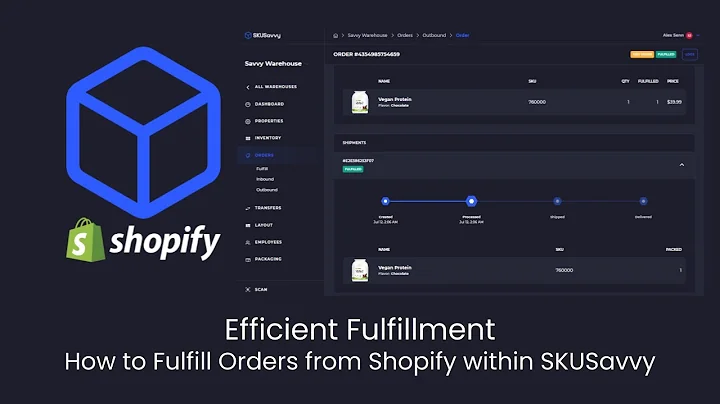Streamline Your Product Organization with Automated Collections
Table of Contents
- Introduction
- What is an Automated Collection?
- Benefits of Using Automated Collections
- How to Create an Automated Collection
- Accessing the Collection Creation page
- Entering Collection Details
- Setting Conditions for the Collection
- Editing Website SEO for the Collection
- Determining Collection Availability
- Adding Image and ALT Text
- Saving the Collection
- Managing Products in the Automated Collection
- Sorting Products in the Collection
- Linking the Collection in the Navigation Bar
- Previewing and Confirming the Collection
- Conclusion
- FAQ
How to Create Automated Collections on Shopify
Have you ever wondered how to automatically group your products based on specific conditions? If so, then automated collections on Shopify are the answer you've been looking for. In this article, we'll explore what automated collections are and how you can easily create them to save time and manage your inventory more efficiently.
1. Introduction
As an online store owner, organizing your products into collections is crucial to make it easier for your customers to find what they're looking for. While manual collections require you to manually assign products to specific categories, automated collections take this process one step further by automatically grouping products based on predefined conditions.
2. What is an Automated Collection?
An automated collection is a curated group of products that are dynamically generated based on specific conditions. These conditions can include product type, tags, prices, and other relevant details. By defining conditions, you can ensure that only the products that meet your criteria are included in the collection. This saves you time and effort in manually assigning products to collections, especially if you have a large inventory that requires regular updates.
3. Benefits of Using Automated Collections
Using automated collections in your Shopify store offers several benefits. Firstly, it saves you time and effort in organizing your products, as the collections are created automatically based on predefined conditions. This means that as you add new products or update existing ones, they will be automatically included in the relevant collections.
Secondly, automated collections help improve the browsing experience for your customers. By grouping products based on specific criteria, it becomes easier for your customers to navigate your store and find the products they're interested in. This can lead to higher conversion rates and increased sales.
4. How to Create an Automated Collection
Creating an automated collection on Shopify is a simple process. Follow the steps below to get started:
4.1 Accessing the Collection Creation page
To begin creating an automated collection, go to your Shopify admin dashboard and click on "Products". From the drop-down menu, select "Collections". On the Collections page, click on the "Create collection" button.
4.2 Entering Collection Details
In the collection creation page, start by entering a title for your collection, such as "T-shirt Sale". Adding a description is optional, but it can be beneficial for SEO purposes if your theme supports it. Enter keywords relevant to the collection in the description to boost its visibility in search engines.
4.3 Setting Conditions for the Collection
Next, select "Automated" as the collection type. In the "Conditions" section, you can choose from various options to define the conditions for including products in the collection. For example, you can select "Product title" as the condition and set it to include products that contain the word "T-shirt" in their title. You can also add multiple conditions to further narrow down the product selection.
4.4 Editing Website SEO for the Collection
To optimize your collection's visibility in search engines, you can edit the website SEO settings for the collection. By default, search engines use the information from the collection's title and description. You can make changes to this section to improve the collection's search engine listing.
4.5 Determining Collection Availability
Choose where you want the collection to be visible by using the "Collection Availability" card. Deselect the checkboxes for channels that you want to exclude. If you want to link the collection in your navigation menu, make sure to keep the "Online store" option selected. You can also schedule the availability of the collection to be published at a future date.
4.6 Adding Image and ALT Text
You have the option to add an image to represent the collection. Keep in mind that adding an image is optional and will only be visible if your theme supports it. If you choose to add an image, make sure to provide ALT text for it. ALT text serves multiple purposes, including assisting visually impaired customers and improving SEO. Keep the ALT text brief and descriptive, preferably within 125 characters.
4.7 Saving the Collection
Once you have made all the necessary changes and settings, click on the "Save" button to create the automated collection. The page will update to show the products that match the conditions you have set. If no products are displayed, double-check your conditions for any spelling mistakes or errors.
5. Managing Products in the Automated Collection
After creating an automated collection, you may need to manage the products included in it. Shopify allows you to easily sort the products in the collection by choosing an option from the dropdown menu. If you prefer a manual sort, you can simply drag and drop the products into the desired order.
6. Linking the Collection in the Navigation Bar
To ensure that your customers can find the newly created collection, you need to link it in your store's navigation bar. This is not done automatically, so you'll have to follow a few simple steps. Go to the "Navigation" section under "Online Store" in your Shopify admin dashboard. From the "Main Menu", click on "Add menu item" and enter a name that matches the collection. In the "Link" field, select "Collections" and find the collection you just created. Click "Add" and use the six-dot icon to drag and drop the menu item to its desired position. Save your changes to update the navigation bar.
7. Previewing and Confirming the Collection
To ensure that the new collection is displayed correctly in your store, you can preview it by clicking the eye icon next to "Online store" in your Shopify admin dashboard. This will open a new browser tab where you can see how the collection fits into the navigation bar and confirm that everything is in working order. You can also open the collection itself to check if all the products and settings are as intended.
9. Conclusion
Creating automated collections on Shopify can drastically simplify the process of organizing and managing your products. By setting conditions and allowing the system to automatically group products, you can save time and provide a better shopping experience for your customers. Explore the various options and experiment with different conditions to optimize your collections and drive sales.
10. FAQ
Q: How many conditions can I add to an automated collection?
A: You can add multiple conditions to an automated collection to ensure that only products meeting all the specified criteria are included.
Q: Can I manually sort products in an automated collection?
A: Yes, you have the option to manually sort products in an automated collection by dragging and dropping them into the desired order.
Q: Can I add more than one image to a collection?
A: Currently, Shopify supports adding only one image per collection. Make sure to choose an image that best represents the collection.
Q: Can I edit the conditions of an existing automated collection?
A: Yes, you can edit the conditions of an existing automated collection at any time to update the criteria for including products.
Q: Will products be automatically added to the collection if they meet the conditions in the future?
A: Yes, any products that are updated to meet the conditions of an automated collection will be automatically included in the collection in the future.






















